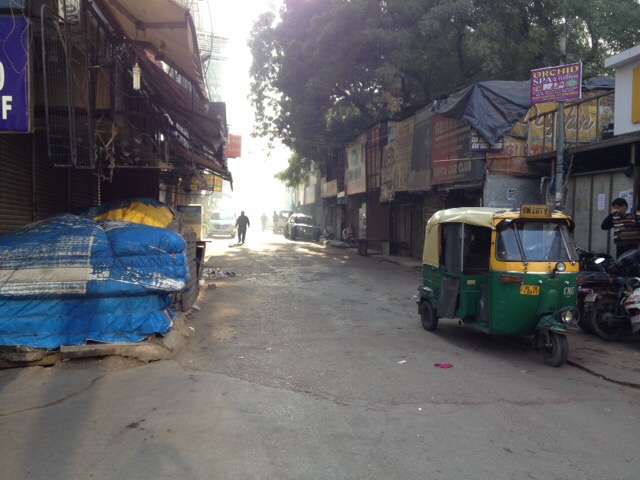Advertisement
Published: January 21st 2017
The ants pour out of their nests in brown droves and by 9 am, the smoke-hazed streets of Delhi are buzzing.
Narrow, busted pavement roads, streets of sand, dust, broken concrete, and dog shit mingle with thin, brown bodies- mostly men – rushing in every direction, some to the huge metro station at the end of the long street, others to set up street stalls selling fruit, vegetables, belts and sunglasses, plastic neon doodads, wrinkled winter jackets in big heaps on carts, and syrupy-sweet gulab jamun.
Like most poor neighbourhoods in most poorer countries, the sounds and smells of this borough called
Karol Bagh within Delhi are an assault, an assault of stimulation where small cars and rusted bicycle carts and dogs and throngs of pedestrians all compete to survive.
The fractious chaos to our western eyes is hard to imagine, but to Pappu the
tuk-tuk owner/driver, it’s everyday life.
Pappu and his tuk-tuk, a small 3-wheeled motorcycle cart that closely resembles the Coco cabs of Cuba, wait outside boutique hotels anticipating any exit by a white-skinned tourist or business person.
Pappu smiles a big, white-toothed smile and chats us up, skilfully applying his salesman skills, all honed and polished towards an end result…”always be closing” in sales parlance.
Pappu draws a promise from us – after 5 minutes of friendly but dogged pursuit – of a tuk-tuk trip to the Lotus Temple.

Bahai faith’s Lotus Temple
The Lotus Temple turns out to be -easily- an hour's return trip through Delhi traffic. The air temperature is cool and invigorating- perhaps 17 or 18C.
It dawns on me that perhaps the bright mustard yellow top and green grass-coloured bottom and sides of the tuk-tuk are intended to represent a typical stop light missing the red stop portion because traffic here never truly stops but is in constant movement even when there appears to be no possible way to progress forwards in the jam of traffic.
The cost of the journey to us? 50 rupees… less than 1 dollar including sightseeing points along the route (and an unsolicited stop at his cousin’s carpet store for a 20 minute sales pitch of lovely Indian carpets served with green tea!!)…
At the end of the fun, air-through-our-hair experience, I hand him a bonus 50 rupees with thanks and a smile. He’ll return to his station by the hotel waiting for his next “fare” with his smile and sales pitch prepared.
Tuk-tuks abound in the thousands in Delhi, for the movement of tourists and many of the 22.5 million residents. The roads of Delhi are jammed in the daytime with cars, trucks, horse and brahma drawn wagons, bicycles, motorcycles and, tuk-tuks… a maelstrom of loud horn-heavy movement where lane lines and sidewalks are generally ignored and vehicles routinely wander within anxious millimetres of each other and the walking masses.
It’s a voluminous sea of humanity beyond what we’ve experienced in other populous countries like China or Morocco, good-natured but cacaphonous. It’s a sensory overload, over-stimulating and exciting, occasionally a bit frightening in the crowded metro stations and marketplaces.
Today, a visit to a Sikh temple where each day, 25,000 people are fed free vegetarian meals prepared in huge kitchens in monster cauldrons. We sit barefoot, cross-legged on long rough carpets laid out in straight lines. Across the dimly lit hall, male volunteers carrying metal pots ladle dal and green pea soup onto our metal dishes, another volunteer follows dropping 2 warm chappatis on each plate. Quietly, hundreds of us, torn bits of chappatis in grasp, scoop the food with the right hand, the right hand only, into our mouths.
These are all early observations formed in the dawn of our visit to this historic land. The scents, the flavours, the sounds, will float us along a sensory river as we carry on, first to Agra and the Taj Mahal tomorrow, then further to Udaipur and Jaipur and Mumbai and Goa.
Each day will send stories, new visions and impressions of the people and the wonders of its food and architecture, its art and history.
In the days to come, there will be stories of India and perhaps, stories of the
BritAusAmerican folks that journeyed here to accompany us on the road to this
Best Exotic Marigold destination.

Tuk-tuk cab on Delhi street
Advertisements
Occasionally, some of your visitors may see an advertisement here<br style="margin: 0px; padding: 0px;" />You can hide these ads completely by upgrading to one of our paid plans.
Advertisement
Tot: 0.076s; Tpl: 0.011s; cc: 6; qc: 44; dbt: 0.0384s; 1; m:domysql w:travelblog (10.17.0.13); sld: 1;
; mem: 1.1mb

